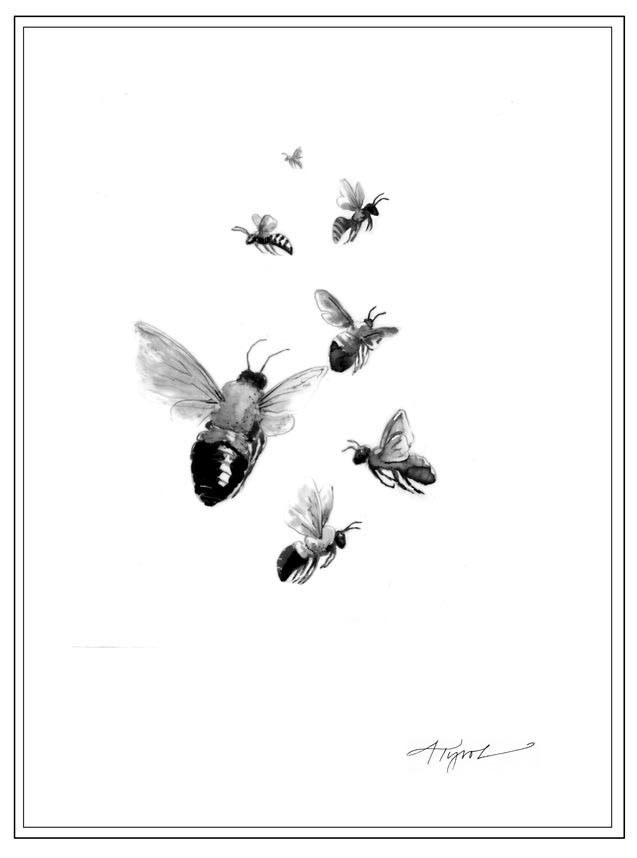
There has been much publicity in the last few years about the alarming losses of honeybees. In 2007, an estimated 30 percent of hives were lost nationwide, largely through a mysterious affliction known as colony collapse disorder. There was talk that commercial agriculture could be close to a pollination crisis. Even our local beekeeper has all but suspended operations under the mounting toll of honeybee diseases and parasites.
But all is not lost. I see the blossoms in my garden constantly visited by bees – not the familiar brown and yellow honeybee, but a variety of other insects, unrecognizable as bees but for the bright yellow clumps of pollen on their legs.
It is surprising to learn that there are about 5,000 species of native bees across the US – about 400 of these are found in the Northeast. The most familiar are the large hairy bumblebees. Like domestic honeybees, bumblebees form colonies with workers and a queen bee. However, the bumblebee colony is small – dozens of bees compared to thousands – and lasts but one season. It is only the new, mated queen bumblebees that will survive the winter to start new colonies the following spring.
The majority of native bees do not form colonies and are known as solitary bees. Their common names often reflect their nesting habit; for instance, there are leafcutter bees that line ready-made tunnels such as hollow stems with leaf fragments, carpenter bees that bore into dead wood, mining bees that dig into the ground, and mason bees that build mud nests in pre-existing holes. So-called sweat bees derive their name from their attraction to human sweat. The diversity of native bees defies concise description – they come in all shapes and sizes. However, a notable feature they share is a reluctance to sting.
Most solitary bees share a common lifestyle. The female mates and constructs several nesting chambers, which may be divided into individual cells. Each cell is stocked with nectar and pollen, packed together to form a ‘loaf.’ An egg is laid in the cell, which is then sealed. After filling all the cells and covering the entrance to the nest, the female bee dies. The eggs hatch and the larval bees feed, grow, pupate, and finally emerge as adult bees. Their development takes about eleven months in all, while adult bees may live as little as three or four weeks. The different species mature at various times throughout the year. About 25 percent of solitary bee species have evolved to take advantage of the hard work of others. Known as cleptoparasites, these bees lay their eggs in other bees’ nests and the larvae hatch, kill the host’s offspring, and eat their provisions. Cleptoparasites lack pollen-gathering structures like rear-leg pollen baskets and body hairs. Instead, they have stronger armor and stings to fend off the female host bee.
Despite their short adult lives, most native bees are very active pollinators. In fact, in many ways they’re superior to honeybees. They fly in cool weather when honeybees will not leave the hive. Many fly much faster than honeybees and thus visit more flowers per hour. And about 20 percent of native bee species specialize in pollinating single groups of plants; this focus makes them very efficient pollinators.
Like many insects, native bees have suffered declines as a result of pesticide spraying and habitat loss. But people can help them out by creating good bee habitat in their backyards. Leaving undisturbed, bare soil on sunny, dry slopes will attract ground nesting bees. Bees that nest in wood or stem cavities will be drawn to dead snags, elder stems, and reeds. You can make bee housing by drilling various sized holes in wooden blocks – there are a number of online resources that offer more specific details for such a project. For mason bees, a source of water and mud is required.
Like us, bees need good nutrition to thrive, and native plants are more nutritious and more attractive to native bees than non-native ones. Good habitat will include a variety of spring-, summer- and fall-blooming flowers and a diversity of flower shapes, from flat to tubular. Weedy borders along hedgerows can be solitary bee magnets, so consider leaving a ‘bee buffer’ when you plant.

